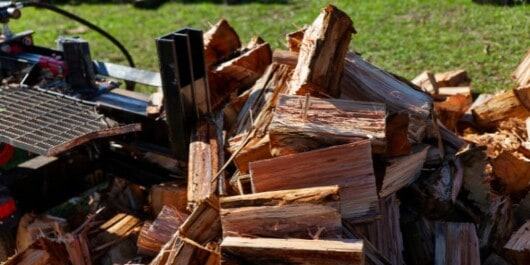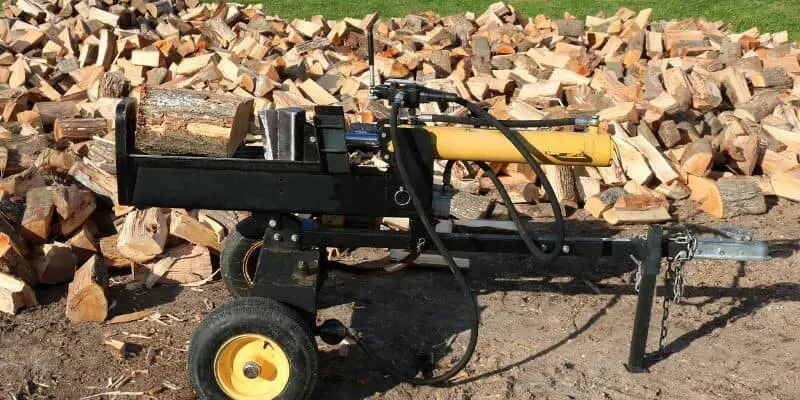Do you own a hydraulic log splitter and want to hook it to a tractor to use it, but don’t know how to? If yes, then you are in the right place.
Hooking up hydraulic log splitter to tractor involves transferring the power to the log splitter directly or using the Power Take Off (PTO) of the tractor to power a separate hydraulic pump. To make the connection, you will have to connect the log splitter with a 3-point hitch or the drawbar of the tractor. A hydraulic log splitter is a great option if you require faster splitting, cleaner cuts, cut different types of hardwood, and keep yourself safe while doing so.
In this article, you will get to know all about connecting hydraulic log splitter to tractor, how do hydraulic log splitters function, how to hook up hydraulic log splitter to tractor, tips to remember when operating a hydraulic log splitter after connecting it to a tractor, and more. Stick around to get all the answers that you are looking for.
Connect your hydraulic log splitter to a tractor
Hydraulic log splitters perform the function of splitting wooden logs using the pressure generated by an engine. A tractor-operator log splitter will be able to operate in one of two ways – the hydraulic system of the tractor will power the splitter directly, or the Power Take Off (PTO) of the tractor will power up a separate hydraulic pump used for operating the log splitter. Connecting the log splitter to a tractor will need little effort and can be accomplished quickly. Before you know how to connect hydraulic log splitter to tractor, you should first know about the workings of hydraulic log splitters.
What are hydraulic systems?
Hydraulic log splitters are among the best tools for landscaping, especially if you’re a homeowner collecting firewood. Whether you are a homeowner with a large property or a professional landscaper, these devices will allow you to split wooden logs with ease and make yard debris much more manageable. However, if you are looking to use these pieces of equipment, it will be vital that you first understand how a hydraulic system works.
To fully grasp the workings involved with a hydraulic log splitter, you will have to first brush up on what a hydraulic system is. A hydraulic system generally consists of several cylinder shafts and a pump to push hydraulic fluid into them. It will produce large amounts of pressure, which will then provide a mechanism with enough power for lifting heavy items or, in this case, cutting through thick wooden logs.
Hydraulics are among the most popular components of any working mechanism, as they’ll reduce the need for manual labor while improving jobsite efficiency. For that reason, you will be able to find them in almost every high-powered piece of equipment for a diverse range of industries.
How does a hydraulic log splitter work?
When it comes to learning how a hydraulic log splitter works, you must know the different functions of each component. This way, you’ll be able to clearly identify their performance while properly gauging how they operate to help you finish the task. These are some of the core parts and functions to keep in mind.
Hydraulic fluid reservoir
A hydraulic fluid reservoir is one of the first parts of this system to take note of. This tank is capable of holding your machine’s supply of hydraulic fluid and then releasing it into the attached tubing once the motor starts running. Reservoirs can hold different amounts of hydraulic fluid depending on the size of the system. It’ll be critical that you know exactly how much your equipment holds to make sure that it is functioning at an optimal level each time.
Tubing and pumping system
After starting your hydraulic log splitter’s engine, the reservoir will release the hydraulic fluid into the attached tubing. Here, it will enter the pump for further distribution. It’ll provide superior control over the machine’s functions while allowing you to identify exactly how much pressure you are using at a given time. Once the hydraulic fluid has been completely used, it’ll pump back into the return valve and through the filter, which will deposit it back into the reservoir for future use.
Directional valves
Once you’ve left the pump, the hydraulic fluid will encounter two directional valves. The first valve connects the tube to the back of the cylinder, and the other one will push the liquid into the front of the shaft. It’ll allow you to easily control the backward and forward movement of the splitting platform in the machine. By directing the hydraulic liquid to the front of the cylinder, the mechanism will push back. Meanwhile, applying pressure to the back of the cylinder will push it forward for use.
Cylinder
With the fluid applying pressure, the cylinders in the main shafts will move back and forth to make room for it. This is what generates the power needed for cutting through wooden logs with ease. It’s essential to note that these cylinders are quite heavy, which is why moving them requires a lot of force.
How to hook up hydraulic log splitters to tractor
A log splitter makes use of hydraulically power-driven moving wedges for splitting wooden logs. The pressure generated by the engine is used for performing the function of splitting wooden logs. The log splitter is connected to your tractor’s hydraulic system, which, in turn, will offer the required power. The power can be easily transferred to the log splitter in the following two ways –
- Provide the power directly from the hydraulic system of the tractor to the log splitter
- The tractor’s Power Take Off (PTO) can provide power to a separate hydraulic pump operating the log splitter

How to direct the power transfer from the tractor’s hydraulic system to the log splitter?
- The first step would be to connect the splitter with a 3-point hitch or the drawbar of the tractor.
- After that, carefully remove the protective caps of the hydraulic couplers. Don’t forget to check for any type of foreign residue like dust or dirt on the couplers. If present, it might interfere with the fittings and result in power transfer issues.
- Identify the couplers of the hydraulic hoses of your splitter and push them directly into the hydraulic receptacles of your tractor. Ensure that the hose of the splitter gets connected with the extended receptacle of the tractor and that the return hose will connect with the return receptacle.
- Make sure that they are locked in place. Double-check for avoiding a loose connection.
- It is done!
How power take-off offers power to the hydraulic pump of the log splitter?
- Start off by connecting the hydraulic log splitter with the tractor. There are a couple of ways you can do so. Place the 3-hitch pin through the drawbar of the tractor and the hitch of the splitter. Alternatively, you can also directly connect the log splitter with pins through the 3-point hitch of your tractor.
- Now, find the PTO shaft of the log splitter and then connect it to the PTO of the tractor. Ensure that you align the splines or grooves of the splitter shaft with the tractor’s stub shaft housing. After that, carefully slide the shaft into the housing.
- Check for the locking mechanism of the stub shaft for ensuring that it is locked into place. If the locking mechanism isn’t present, use a security pen for ensuring the same.
- Go and start the tractor. After that, engage the power take-off of the tractor such that it provides the needed power to the hydraulic log splitter’s hydraulic system.
- You can now operate the log splitter using its control panel.
Useful tips to remember for the safe operation of the log splitter
1. Refer to the instruction manual
Before you begin, you’ll need to refer to the instruction manual of your tractor. If it isn’t available, you should get in touch with your tractor’s dealer. You’ll need to know the safety information and other instructions about how you can connect the log splitter to the hydraulics system of the tractor. There are different models and variations present in the market for hydraulic connections on tractors. Hence, it’ll be even more essential before you begin hooking up the log splitter to the tractor.
2. Turn off the tractor
It’s advised that your tractor have to be turned off and engaged the parking brake before you begin to connect the log splitter with the tractor.
3. Double-check the connections
There is a high chance that a loose, improperly connected log splitter can dislodge at some stage during operation or transportation. It can result in serious injuries to anyone, whether you’re the operator or a bystander. Make sure that your log splitter is hooked up properly. Moreover, double-check the hitch pins so that they are engaged completely before you drive the tractor or start the operation.
4. Make sure the fittings are tight
Ensure that the fittings are tight before you begin the operation, and then apply a bit of pressure. The hydraulic system features high fluid pressures and temperatures. If there’s a loose-fitting, fluid can escape through the system and can result in serious burns or punctures on the skin. It can result in wounds, causing blood poisoning, infections, amputation, or any other disability.
Conclusion
Thank you for reading. Hopefully, now you know a lot more about connecting a hydraulic log splitter to a tractor, how do hydraulic log splitters function, how to hook up a hydraulic log splitter to a tractor, tips to remember when operating a hydraulic log splitter after connecting it to a tractor, and more. Hooking up a hydraulic log splitter to a tractor involves transferring the power to the log splitter directly or using the Power Take Off (PTO) of the tractor to power a separate hydraulic pump.
To make the connection, you will have to connect the log splitter with a 3-point hitch or the drawbar of the tractor. A hydraulic log splitter is a great option if you require faster splitting, cleaner cuts, cut different types of hardwood, and keep yourself safe while doing so.


